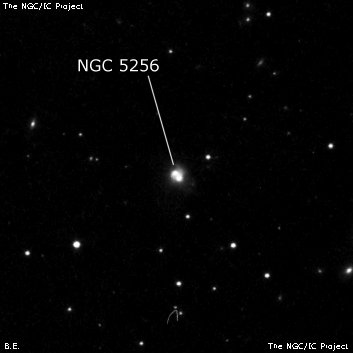
This is a well-studied merging system consisting of a Seyfert 2 and a LINER galaxy with the compact nuclei separated by just 10" [physical separation ~15,000 l.y.].
William Herschel discovered NGC 5256 = H III-673 = h1656 on 12 May 1787 (sweep 734) and recorded "cF, S, R, lE." JH made the single observation "vF; R; vS; gbM; 10"; in field with a double star [HJ 2667]." His position is 1' too far north.
400/500mm - 17.5" (5/11/02): fairly faint, fairly small, slightly elongated SW-NE, 0.8'x0.6', irregular surface brightness. A mag 15 star is 1.0' NW of center. Located 5.5' ENE of an evenly matched pair (HJ 2667) of mag 11 stars at 14" separation.
600/800mm - 24" (6/4/16): at 322x; fairly faint to moderately bright, fairly small, elongated 4:3 SW-NE, 40"x30", brighter ill-defined core, uneven surface brightness. Occasionally, a brighter quasi-stellar knot (nucleus of the merged companion) would pop on the northeast end of the glow [the nuclei are separated by just 10"!]. HJ 2667, a wide pair (14") of mag 11 stars, lies 5.6' WSW.
900/1200mm - 48" (5/10/18): at 488x; fairly bright or bright, roundisht, very strong concentration with two easily visible nucleus separated by 10". The brighter (north-northeast) core is ~8"-10" with a sharp stellar nucleus. The fainter (south-southwest) core is 6"-8" diameter. The outer halo has a low surface brightness. HJ 2667, a 14" pair of mag 11 stars, lies 5.6' WSW. MCG +08-25-030, situated 1' SE of this pair, appeared moderately bright, elongated ~2:1 NW-SE, ~20"x10".
Notes by Steve Gottlieb